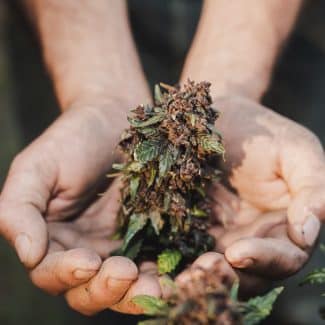
How Cannabis Cultivators Respond to Bumper Harvest vs. Low Demand
Across the legal market, cannabis cultivators report a banner year. With unseasonably warm weather into October and no adverse weather events, this year’s outdoor-grown cannabis is a bumper harvest. And that may be bad news for the market. Surprised? Let’s explore.
Across the legal market, cannabis cultivators report a banner year. With unseasonably warm weather into October and no adverse weather events, this year’s outdoor-grown cannabis is a bumper harvest. And that may be bad news for the market. Surprised? Let’s explore.
Understanding the Bumper Cannabis Harvest of 2022
The 2022 October harvest was particularly fruitful, producing a bumper harvest (an expression for an unusually productive crop year.)
Most results of sun-grown cannabis come down to luck, and this year, cultivators across the country got lucky. While indoor-grown plants can be harvested year-round, sun-grown plants are harvested in October (known as Croptober), typically after the first frost or when temperatures drop below freezing. Cannabis plants that can last outside until October produce more trichomes when the weather gets cold.
Sun-grown plants are subjected to the whims of Mother Nature. States, including California, Colorado, and Michigan, saw generally favorable summer growing conditions. Annual wildfires in states like California or Colorado didn’t reach the same fervor as last year, so no events destroyed fields or lowered air quality. Additionally, there wasn’t too much rain and plenty of sun — all of which spells happy cannabis plants.
While this should mean good news for cultivators, the market is currently seeing low prices on flower. This means that potential profits aren’t what they should be. Overproduction isn’t a new problem for the cannabis industry, but managing too much weed can present unique challenges for business owners.
Why Overproduction of Cannabis Is a Problem
Although the cannabis industry is growing like a weed, there simply isn’t enough demand to keep pace with production. Regulation changes move slowly at a governmental level, and developing states take months, if not years, to come online. Since a lack of interstate commerce means each legal market is an island, it becomes clear why the excitement over cannabis has surpassed consumer demand. (Although California is attempting to address this.)
Low wholesale costs in cannabis are a trend that has been playing out for a few years. We saw it first when CBD prices hit bottom, with the initial influx of farmers after the 2018 Farm Bill, and we’re seeing it again now. Bumper harvests combined with low demand mean wholesale prices drop. These low selling prices create challenges for cannabis cultivators, who can’t afford to sell their crops at a discount — but can’t afford to hold onto them either.
The biggest problem with having too much weed is that cannabis is shelf-stable, but trichomes (the resin in the plant that holds the cannabinoids and terpenes) are not. It quickly degrades if the plant isn’t stored properly in a dark, temperature-stable environment. Cannabis cultivators are forced to choose between taking a financial loss to sell a product or a crop loss if it sits in storage.
It’s not all bad news, though — MJBiz reports that in some states “such as California and Colorado…the continuous low prices have caused some larger cultivators to opt-out of planting and instead leave their fields fallow this year, reducing competition somewhat.”
How Cultivators Can Protect Themselves
So what’s a cannabis cultivator to do with a bumper harvest?
- Let the soil rest. Let your fields lie fallow, or enroll your land in CRP (Conservation Reserve Program) for a specific time frame. Since farmers get paid by the government for land in the CRP, this could offset some of the revenue lost.
- Create other avenues of revenue. Cannabis is a multipurpose plant. Can your harvested flower be sold to a processor, pressed into an extract, white-labeled, and sold? Can you sell the stalks to industrial processors to be made into a hemp product?
- Invest in long-term storage or innovative storage techniques. Proper storage is the key to preserving cannabis plants for any amount of time. While the up-front cost of investing in proper storage can be high, the ROI comes when years like this one happen, and cultivators can sit on their crop, knowing the potency is preserved while others have to throw out flower.
- Insure your crops. You can insure your cannabis crops to protect your bottom line during years when prices are low and production outpaces demand with policies like crop coverage, EPL, and general liability.
What We Expect for Cannabis Cultivators in the Future
This year isn’t the first that supply has outpaced demand, and it won’t be the last. The cannabis industry is navigating many challenges and changing regulations, and it will take time for the market to even out.
We anticipate cultivators and growers re-thinking their cannabis harvest, potentially adjusting their business to be more versatile and multi-channeled. Whether that means planting fewer crops for next year or choosing to process some flower into a product.
The government may step in and offer more CRP opportunities as the market continues to mature. This approach benefits more extensive grow operations using Western farming methods and depleting the soil.
Though it was a great year for crops, it’s been a year of ups and downs in the industry. Demand is down, there’s a decline in job opportunities, and uncertainty is on the horizon. But the industry is like the plant itself; resilient, adaptive, and here for the long haul.
Protecting your cannabis company can seem confusing; however, we’re a full-service insurance brokerage working with carriers worldwide to offer you the best coverage possible. We’re here to help! Please reach out to us today by emailing [email protected] or calling 646-854-1093 for a customized letter of commitment or learning more about your cannabis insurance options.





